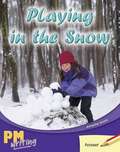- Table View
- List View
More NIMAC books are available at www.nimac.us. If you find your title in the NIMAC and not in Bookshare then please contact us to request it.
Plants We Use (Into Reading, Level K #89)
by Lisa ShulmanWe use plants to make books, clothing, and other things. Find out how we use different parts of plants to make the things we need.
Plastic Eaters: Wax Worms on the Job (Fountas & Pinnell Classroom, Guided Reading Grade 6)
by Catherine JohnWorms Hold the Key Plastic is piling up everywhere, clogging landfills and oceans. Even as people around the globe recycle and reuse plastic, the problem persists. But scientists may have discovered a solution: WORMS! Yes, wax worms may hold the key to solving our plastic problem. Read on to discover why scientists are so excited about these white wiggly worms. NIMAC-sourced textbook
Plásticos: ¿Son buenos o malos? (¡Arriba la Lectura!, Level S #16)
by Phillip SimpsonNIMAC-sourced textbook
Play On! (Into Reading, Level S #27)
by Carmel Reilly Martin FaganNIMAC-sourced textbook. Sam is a star player on the school basketball team. But when he is chosen for a role in the school play, he's under pressure to find time for both basketball practice and play rehearsals. Will he be able to balance his commitments?
Playing in the Snow (Into Reading, Level J #18)
by Annette Smith Lyz Turner-ClarkNIMAC-sourced textbook A girl has written a letter to her dad about a special day she shared with her mom.
Plunged into Darkness: Understanding a Total Solar Eclipse (Fountas & Pinnell Classroom, Guided Reading)
by Elizabeth Rusch Isabelle RuschNIMAC-sourced textbook
El poderoso Misisipi (¡Arriba la Lectura!. Level I #8)
by Patricia KummerEl Misisipi es un río poderoso. Lee este libro para saber más. NIMAC-sourced textbook
El poderoso roble (¡Arriba la Lectura!, Level J #1)
by Lisa Trumbauer Vicki JacobsonNIMAC-sourced textbook
Point Wild (Fountas & Pinnell Classroom, Guided Reading Grade 6)
by Bradley Wilson Andrew BosleyHER FIRST MISSION Ora is a new Hunter, part of a group of explorers. She has been chosen to explore Point Wild—a forest that could hold the key to her people's survival, and also to a mystery that Ora must solve. NIMAC-sourced textbook
Por qué Coyote aúlla a la luna (¡Arriba la Lectura!, Level K #38)
by Rob Arego Vicki BradleyCoyote quiere atrapar a Conejo para comérselo, pero Conejo tiene un plan. ¿Funcionará? Lee la historia para descubrir qué pasó. NIMAC-sourced textbook
Por qué el leopardo tiene manchas (¡Arriba la Lectura!, Level L #51)
by Katherine Mead Barry RockwellEl leopardo no siempre ha tenido manchas. ¿Cómo crees que las consiguió? NIMAC-sourced textbook
¿Por qué la luna es de marfil? Cuento popular vietnamita (¡Arriba la Lectura!, Level Q #34)
by Cheryl Noll John ManosNIMAC-sourced textbook
Por qué migran los animales (¡Arriba la Lectura!, Level N #44)
by Debbie CroftLa migración es importante para muchos animales. Los animales migran buscando una alimentos, áreas más cálidas donde vivir y lugares seguros donde tener sus crías. Descubre cuándo, dónde y por qué migran los animales. NIMAC-sourced textbook
Potato Travels (Fountas & Pinnell Classroom, Guided Reading Grade 4)
by Christy PetersonNIMAC-sourced textbook
La potencia del viento (¡Arriba la Lectura!, Level S #68)
by Jill BryantEl viento es aire en movimiento. Sirve para viajar y divertirse, y como fuente de energía renovable. Se cree que, en el futuro, el viento va a producir gran parte del suministro de la electricidad de todo el mundo. El viento también es un factor clave de fenómenos meteorológicos extremos, como los tornados y los huracanes. Ficción realista Nivel S • 2,837 palabras El viento es aire en movimiento. Sirve para viajar y divertirse, y como fuente de energía renovable. Se cree que, en el futuro, el viento va a producir gran parte del suministro de la electricidad de todo el mundo. El viento también es un factor clave de fenómenos meteorológicos extremos, como los tornados y los huracanes. Estudiamos el viento para aprovechar su potencia para generar energía, y también para proteger a las casas y otros edificios de las tormentas destructivas. NIMAC-sourced textbook
The Power of Style (Fountas & Pinnell Classroom, Guided Reading)
by Brian McGrathNIMAC-sourced textbook. EGYPT UFELE was bullied in school because she was different. At first, learning to sew was a way of forgetting her pain and loneliness. But within a few years, she went from making clothes for her dolls to designing chic outfits for herself. When she was invited to show her clothing collection at New York City Fashion Week, this tween fashionista realized her talent and effort had won out over the bullies.
The Power of Wind (Into Reading, Level P #68)
by Jill Bryant<p>NIMAC-sourced textbook. <p>Wind is moving air. People make use of wind for transport and recreation, and as a source of renewable energy. In the future, wind power is expected to provide a large part of the world's electricity supply. <p>Wind is also a key factor in extreme weather events, such as tornadoes and hurricanes. People study the wind in order to use its power for energy, and to protect homes and infrastructure from damaging windstorms.</p>

